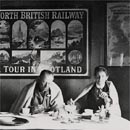William Inglis Clark Mountaineer
William Inglis Clark / Mountaineers
- Name : Clark
- Born : 1856
- Died : 1932
- Category : Mountaineers
- Finest Moment : 1st Ascent Raeburn's Arete (30th June 1902); 2nd ascent Crowberry Ridge Direct (1902); inventor drug capsules
Although an Edinburgh man, William Inglis Clark was born in Bombay, India, where his father was minister of the Scots Church. (For the puzzled who might hear the name Inglis spoken in Scotland, it is pronounced "Ing-gils".) Sadly, his mother died of cholera, leading to his return to Edinburgh when one year old, accompanied by his older brother.
Clark, aged nine, made a night ascent of Goatfell on Arran with his brother, to watch the sunrise. He had an uncle, Charles Simson Clark, who had climbed Ben Nevis at least 45 times. He was probably influential in his nephew's mountaineering development and it is known that on one early ascent of Nevis by Clark, he met two important figures in mountaineering circles on the Ben; Foster Heddle, Professor of Chemistry at St Andrews and Colin Philip, a noted watercolour artist and SMC member. Heddle was also interested in geology and was one of the first Honorary Members of the SMC.
Clark entered Edinburgh University to study chemistry. There he proved to be a brilliant student, gaining a D.Sc. before he was 21. Indeed, he was forced to wait until that age before he could be formally "capped". He then left academia to work in the lab of Messrs Duncan Flockhart and Co. later becoming a partner.
Demonstrating his inventive nature, Clark worked out a method for encapsulating ill-tasting drugs, also inventing the machinery necessary to produce the capsules. As a wealthy citizen of Edinburgh, he was able to purchase that city's first motorcar, possessing the registration S1. However, he passed this on to Lord Kingsburgh, the 1st President of the Automobile Association and instead used the next registration, S2, for his own use. This he had placed on an Arrol-Johnston "dog-cart". In Switzerland, he was stopped and fined for driving at 9 m.p.h.
Clark joined the SMC in 1895 and soon made a mark with his enthusiasm and energy, becoming Secretary for 11 years and President from 1914-19, covering the years of the Great War. Connected to his profession as a chemist was a great interest in photography. Not content with normal black and white photography, he experimented in colour and the SMC Journal for 1909 published several of his colour prints. It was not until 1993, some 84 years later, that the SMC Journal switched to colour photographs on a regular basis.
As a mountaineer, Clark was also very competent and seconding Raeburn in 1902, along with his wife Jane, he made the second ascent, and first Scottish ascent, of Crowberry Ridge Direct, then the hardest rock climb in Scotland. His wife Jane, a very fine climber, became the 1st President of the Ladies Scottish Climbing Club.
In June 1902, the Clarks were staying in the small summit hotel on Ben Nevis. Along with G.T. Glover, they made the 2nd ascent of the Very Difficult Staircase Climb, on the west flank of Carn Dearg Buttress. The following day, they made the 1st ascent of Glover's Chimney, the gully which descends from Tower Gap. On the 3rd day of this heat wave, the same trio climbed Pinnacle Buttress of The Tower. It was from the finish of this route that they spied Raeburn, making his solo ascent of Observatory Buttress. Raeburn had arranged to meet up with the Clarks but had been delayed when sailing in the Firth of Forth, ironically by the same good weather, which was making the climbing so good.
The next day the Clarks teamed up with Raeburn, to make the 1st ascent of Pinnacle Buttress on the South Trident Buttress. It was an impressively steep route, with the rope, Clark observed, hanging parallel to the rocks at several points on the climb. All of this, however, was a warm up for Monday's climb, the 1st ascent of the Severe Raeburn's Arete on the First Platform, North-East Buttress.
This brilliant route is still awarded the full three stars in the current SMC guide to the mountain and with its steep, slabby rocks and corners, its high quality rock and exposed positions, it was a superb lead by Raeburn years ahead of its time. It was also another indicator of the competence of the Clarks. As a sign of Raeburn's pre-eminence, it was either on this, or a later ascent of the same route, that Clark described Raeburn soloing alongside them!
The Clarks had two children; a daughter, Mabel, who would become President of the LSCC in it's 21st year and Charles, who would also be an excellent mountaineer and SMC member. Tragically, Charles would be killed in 1919, in the dying months of World War I, in what is now modern Iraq. He was buried outside Baghdad. It was as a memorial to their son that the Clarks paid for the building of the SMC hut on Ben Nevis, the Charles Inglis Clark Memorial Hut. It was finished in 1929, with the formal opening on April 1st. The Inglis Clarks went up by pony the day before. There is, as an interesting point for mountaineering historians, a cine film of the opening ceremony.
William Inglis Clark had an immensely happy family life. After his death his wife Jane wrote a book on their gardens and there is no doubt that throughout their life together they shared the pleasures and pains fully in accord with one another. He died in 1932.


